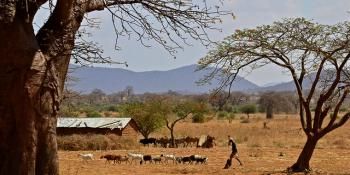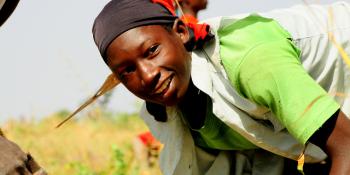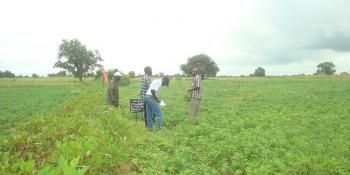Developing pest-smart farmers in Cambodia
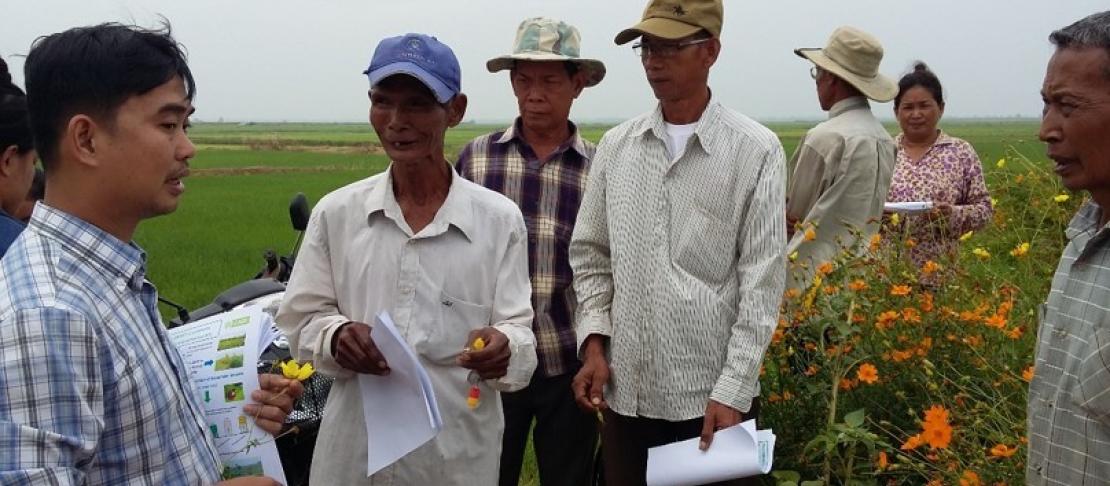
In Rohal Suong Climate-Smart Village, adoption of ecological engineering practices has improved farmers’ ability to prevent pests and diseases outbreaks while reducing pesticides use.
Every year, a great portion of Cambodian farmers’ income is at risk because of possible pests and diseases (P&D) outbreak. Aside from the inadequate knowledge of farmers, climate change aggravates the problem on managing P&D.
Cambodia is one of the countries in Southeast Asia that is highly affected by the impacts of climate change. From the enormous floods in 2011 to the prolonged droughts in 2016, Cambodian farmers have been increasingly exposed to the negative effects of climate-related risks, both in terms of crop growth and P&D outbreak. Higher temperatures and increased periods of rain can speed up pest cycles and can worsen the current phytosanitary condition of rice crops. Extended droughts can even lower the resistance of rice plants to grasshoppers, and stronger winds can hasten the spread of Brown Plant Hopper (BPH).
There is still much work that needs to be done in promoting sustainable agricultural practices to Cambodian farmers. Improper and excessive use of fertilizer is still one of major agricultural issues in the country. Farmers apply pesticides that are often not safe or counterfeit. Aside from being an unnecessary expense, this also results in an opposite intended outcome, which is the reinforcement of pest outbreaks by increasing pest resistance. Most farmers are unaware that repeated insecticide treatments can induce resistance in insect populations such as BPH.
To help Cambodian farmers cope with these problems, the Centre for Agriculture and Biosciences International (CABI) Southeast Asia with support from the CGIAR Research Program on Climate Change, Agriculture and Food Security in Southeast Asia (CCAFS SEA), conducted “pest-smart” interventions. This project is piloted in Rohal Soung village in Cambodia, which is one of the Climate-Smart Villages (CSVs) under CCAFS SEA.
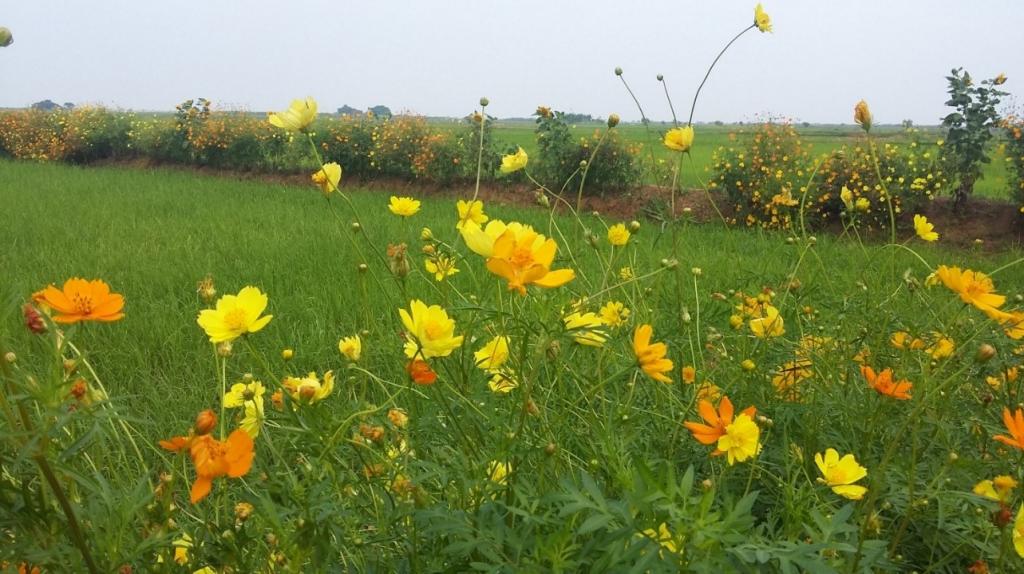 Cosmos flowers set on rice bunds in the Climate Smart Village (CSV) of Rohal Suong, Cambodia. Photo: A. Costa (CABI)
Cosmos flowers set on rice bunds in the Climate Smart Village (CSV) of Rohal Suong, Cambodia. Photo: A. Costa (CABI)
Introducing ecological engineering
As one of the pest-smart interventions, the use of ecological engineering (EE) to control P&D was introduced in Rohal Soung village. Trainings were conducted to increase the capacity of extension workers and farmers on pest-smart technologies and practices.
In one of the trainings, Dr. HV Chien, a specialist on EE approaches and the former director of Southern Regional Plant Protection Center, shared with the farmers the issues on BPH and the current misconception of pesticide use against this pest. Dr. Chien stressed that pesticide application during the first 40 days is often ineffective in controlling BPH. Since the eggs are laid on the lower parts of the rice stems, initial pesticide applications kill the natural enemies, which can be a key component to sustainably control BPH infestation.
After the lectures, farmers were involved in setting up EE pilot testing plots. Selected rice bunds were planted with yellow and orange Cosmos plant (Cosmos sulphureus) to attract natural enemies to thrive in the rice fields. This activity served as a participatory training platform for farmers to facilitate better and faster understanding of the EE practice and its benefits. Mr. Kheun Kkon, one of the farmer participants, hoped that “more international experts can come here to implement new techniques that promote minimal use of toxic products to grow rice. I am interested to learn how to prevent pests and diseases in my region with greener technologies, and to pass my knowledge to other farmers living in Rohal Suong and nearby communities.”
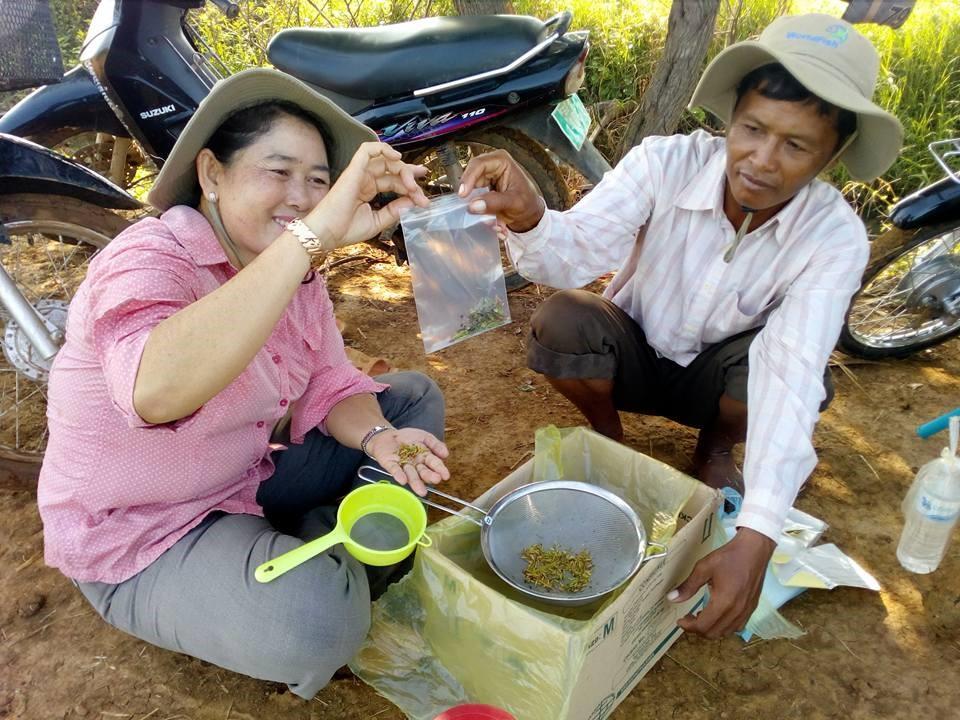 Farmers participated in sampling of beneficial insects on EE fields. Photo: A. Costa (CABI)
Farmers participated in sampling of beneficial insects on EE fields. Photo: A. Costa (CABI)
Pest-smart farmers
Being part of the EE development and implementation in Rohal Soung, farmers were also involved in the evaluation of the EE pilot testing plots. Using sweeping nets, farmers were able to check the presence of natural enemies both in EE pilot plots and in controlled plots. More natural enemies were present in EE plots due to the presence of Cosmos flowers and the reduced insecticide treatment during the first 40 days of the rice crop.
With the use of EE, pesticide application can be reduced significantly, and this can contribute significantly in mitigating climate change. No insecticide is sprayed during the first 40 days, which results in a substantial reduction of pesticide use. Reduction of greenhouse gas emissions and greater benefits can be obtained if this practice will be outscaled in the region.
Increased interest from local farmers was also observed because of the positive results of the EE pilot plots compared to the conventional system. Mr. Kim Torn, one of the farmer leaders, stressed that “our village is ready to use the Cosmos flowers in a larger area, and we are enthusiastic to develop safer ways to grow rice, with less pesticide use.”
Read more:
- CCAFS blog: Pest Smart interventions: Paving the way to pest and disease resilient rice farms
- CCAFS blog: Climate change puts Southeast Asia’s billion dollar cassava industry on high alert for pest and disease outbreaks
- CCAFS blog: “Pest-smart” to climate-smart in Southeast Asia
Dr. Arnaud Costa is the Integrated Crop Management Advisor of CABI Southeast and East Asia.

